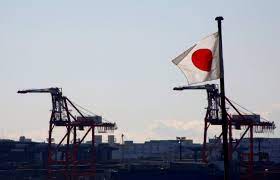
In March, Japan's trade imbalance was more than four times larger than market expectations, as China-bound exports slowed abruptly and rising energy costs upped the cost of imports, compounding the economic woes brought on by the Ukraine conflict.
Data revealed that outgoing commerce was hampered by a drop in auto exports and a slowdown in the growth of shipments to Japan's largest trading partner, China, showing that global supply restrictions and the coronavirus outbreak remain a threat.
The ongoing trade deficit underlines the susceptibility of the world's third-largest economy to rising import costs.
"Japan's economy may see a slower recovery if China-bound exports are sluggish," said Takeshi Minami, chief economist at Norinchukin Research Institute. Exports to China make up over a fifth of Japan's total shipments in value terms, he said.
According to Ministry of Finance figures released on Wednesday, imports increased 31.2 per cent in the year to March, exceeding the median prediction of 28.9 per cent in a Reuters survey of experts.
This exceeded a 14.7 per cent increase in exports, resulting in a trade deficit of 412.4 billion yen ($3.19 billion), much exceeding the poll's expectation of 100.8 billion yen.
The shortfall in March was the eighth in a row, although it was the smallest in five months.
Exports to China increased by only 2.9 per cent in the year to March, aided in part by higher shipments of audiovisual projectors. This was a significant drop from the previous month's 25.8 per cent.
"China's zero-coronavirus policies and lockdowns in cities caused production activity to shrink, hurting Japanese exports of parts and capital goods," said Norinchukin's Minami.
Exports to the United States, the world's largest economy, increased by 23.8 per cent, thanks to increased shipments of auto parts and power-generating gear.
However, a 0.7 per cent reduction in motor vehicle shipments weighed down overall exports.
Larger supplies of oil from the United Arab Emirates, as well as coal and liquefied natural gas from Australia, pushed up imports, according to the data.
"Net trade is set to have knocked off around 0.5 percentage point from GDP (gross domestic product) growth last quarter as import volumes rose a lot faster than export volumes," said Tom Learmouth, Japan economist at Capital Economics.
"But driven by the Japanese staples of cars and capital goods, we think exports will soon start to outpace imports."
According to a separate Reuters survey of economists, Japan's economy is expected to grow at an annualised rate of 4.9 percent in the current quarter, owing to a rebound in consumer activity following the government's decision to lift coronavirus pandemic restrictions last month.
However, the yen's fast depreciation versus the dollar, which has dropped to two-decade lows on expectations of widening US-Japan interest rate differentials, is inflating already growing import costs for fuel and food, putting downward pressure on household purchasing power.
(Source:www.reuters.com)
Data revealed that outgoing commerce was hampered by a drop in auto exports and a slowdown in the growth of shipments to Japan's largest trading partner, China, showing that global supply restrictions and the coronavirus outbreak remain a threat.
The ongoing trade deficit underlines the susceptibility of the world's third-largest economy to rising import costs.
"Japan's economy may see a slower recovery if China-bound exports are sluggish," said Takeshi Minami, chief economist at Norinchukin Research Institute. Exports to China make up over a fifth of Japan's total shipments in value terms, he said.
According to Ministry of Finance figures released on Wednesday, imports increased 31.2 per cent in the year to March, exceeding the median prediction of 28.9 per cent in a Reuters survey of experts.
This exceeded a 14.7 per cent increase in exports, resulting in a trade deficit of 412.4 billion yen ($3.19 billion), much exceeding the poll's expectation of 100.8 billion yen.
The shortfall in March was the eighth in a row, although it was the smallest in five months.
Exports to China increased by only 2.9 per cent in the year to March, aided in part by higher shipments of audiovisual projectors. This was a significant drop from the previous month's 25.8 per cent.
"China's zero-coronavirus policies and lockdowns in cities caused production activity to shrink, hurting Japanese exports of parts and capital goods," said Norinchukin's Minami.
Exports to the United States, the world's largest economy, increased by 23.8 per cent, thanks to increased shipments of auto parts and power-generating gear.
However, a 0.7 per cent reduction in motor vehicle shipments weighed down overall exports.
Larger supplies of oil from the United Arab Emirates, as well as coal and liquefied natural gas from Australia, pushed up imports, according to the data.
"Net trade is set to have knocked off around 0.5 percentage point from GDP (gross domestic product) growth last quarter as import volumes rose a lot faster than export volumes," said Tom Learmouth, Japan economist at Capital Economics.
"But driven by the Japanese staples of cars and capital goods, we think exports will soon start to outpace imports."
According to a separate Reuters survey of economists, Japan's economy is expected to grow at an annualised rate of 4.9 percent in the current quarter, owing to a rebound in consumer activity following the government's decision to lift coronavirus pandemic restrictions last month.
However, the yen's fast depreciation versus the dollar, which has dropped to two-decade lows on expectations of widening US-Japan interest rate differentials, is inflating already growing import costs for fuel and food, putting downward pressure on household purchasing power.
(Source:www.reuters.com)





